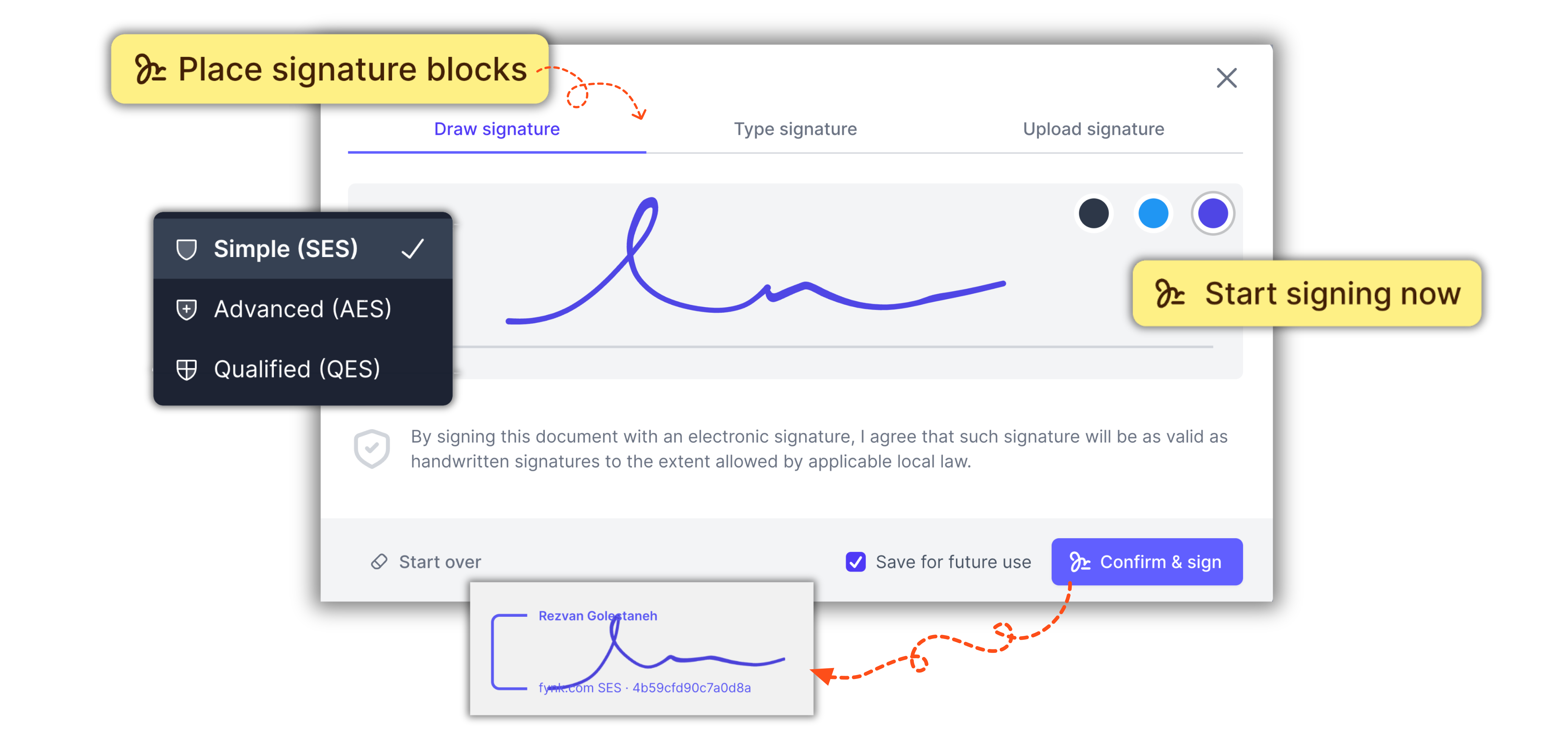Contract Signatory - Learn Everything Before You Sign
Signing a contract might seem simple, but it carries more weight than most people realize. Whether you’re agreeing to a new job, sealing a business deal, or authorizing a company decision, the moment you put your name on the page, you take on legal responsibility. That’s why understanding who can be a signatory, what that role involves, and how the signing process works is essential. In this guide, you’ll learn everything you need to know before you commit to any contract.
- TL;DR
- What is a contract signatory?
- Who can be a contract signatory?
- Signatory vs. signature vs. signer vs. signee
- What is an authorized signatory?
- Co-signatories and multiple signatories
- Roles and responsibilities of a contract signatory
- The signing process: from physical to electronic
- Is it risky to be a contract signatory?
- Contract signatory examples
- Ready to sign a contract?

TL;DR
- A contract signatory is the person with legal authority to sign and commit to the contract’s terms.
- You must have the right legal capacity and authorization before signing.
- Signatories are responsible for negotiation, execution, oversight, and even dispute resolution.
- Signing can be physical or electronic, but legal enforceability always depends on proper identity verification and documentation.
- Being a signatory carries risks like overstepping authority or violating internal policies.
- Always check your authority, understand the contract, and follow your organization’s rules before signing.
What is a contract signatory?
A contract signatory is the person or entity that makes a contract legally binding by signing it. When you sign a contract as a signatory, you’re not just putting your name on paper. You’re agreeing to the terms, taking on responsibilities, and committing to uphold your end of the deal.
Who can be a contract signatory?
To be a valid contract signatory, you must have both the legal capacity and the proper authority. Not everyone qualifies, and failing to meet the criteria can render a contract unenforceable. Here’s what that means:
- Legal capacity: You must be of legal age, mentally competent, and fully aware of the obligations you’re accepting. Without this, your signature may be challenged.
- Signing on your own behalf: In personal agreements, you usually sign for yourself, assuming full responsibility for the terms.
- Authorized signatory for organizations: In a business setting, you need formal authority to bind the company. This is often granted through:
- Job titles (e.g., CEO, CFO, general counsel)
- Company bylaws or board resolutions
- Delegation of authority policies
- Ad hoc signers: Sometimes, temporary authority is granted for a specific deal. This can be valid if well documented, but carries more legal risk if not clearly defined.
- Internal signing rules: Organizations often have limits on who can sign contracts based on the type or value of the agreement. For example:
- Managers may sign up to a certain dollar amount
- High-value or long-term contracts may require executive approval or co-signing
Signatory vs. signature vs. signer vs. signee
It’s easy to confuse terms like signatory, signature, signer, and signee, but they serve different purposes.
- Signatory: This is you if you have the legal authority to sign a contract. Being a signatory means you are taking on the legal responsibilities outlined in the agreement.
- Signature: This is the physical or digital mark that confirms acceptance. It only carries legal weight when it comes from a valid signatory.
- Signer: This term refers to the person who actually signs the contract. It is often used casually, but not everyone who signs is legally authorized.
- Signee: This word usually refers to the person who receives or accepts a signed contract. It is not commonly used in legal documents and often creates confusion.
What is an authorized signatory?
An authorized signatory is someone who has formal approval to sign contracts or legal documents on behalf of a company, organization, or another person. If you’re acting in this role, your signature has the power to legally bind the entity you represent.
In most companies, this authority is granted through clear delegation procedures. You might be authorized by company bylaws, a board resolution, or a specific delegation of authority document. It is your responsibility to know exactly what you’re allowed to sign.
Co-signatories and multiple signatories
Some contracts require more than one signatory. If you’re a co-signatory, you share the legal responsibility for the agreement with others. This is common in corporate, government, or high-value contracts where decisions involve multiple stakeholders.
Each signatory may represent a different department, partner, or side of the agreement. For example, a sales director and a finance officer might both need to sign a large vendor contract to ensure cross-functional approval.
In some cases, all signatories must sign for the contract to be valid. In others, only one signature may be needed depending on the type of agreement and internal rules. It’s your job to understand these requirements before you sign.
Being a co-signatory means you are not acting alone. You must coordinate with others, ensure alignment, and share in the accountability. When multiple signatories are involved, clarity and communication are essential to avoid legal or operational issues later.
Roles and responsibilities of a contract signatory
As a contract signatory, your role goes far beyond simply signing a document. You are involved throughout the entire contract lifecycle, from preparation to enforcement. Here’s what that involves:
- Negotiation and drafting
- You may not write the contract yourself, but you should fully understand its terms.
- You are responsible for ensuring the agreement is fair, clearly written, and aligned with your goals or those of your organization.
- If problems arise later, your signature becomes a reference point for accountability.
- Legal commitment after signing
- Once you sign, you are legally bound to the contract’s terms.
- You must follow through on commitments, meet deadlines, and deliver on obligations.
- If you sign on behalf of an organization, you carry the weight of that responsibility for the business.
- Monitoring and oversight
- You may be expected to track the contract’s progress and ensure both sides are meeting their responsibilities.
- Staying involved through regular check-ins and communication helps prevent issues before they escalate.
- Dispute resolution
- If a conflict arises, you may need to explain the original intent of the contract.
- Your involvement can influence how disputes are interpreted and resolved, especially if your decisions shaped the agreement.
The signing process: from physical to electronic
Whether you use a pen or a digital platform, the process carries serious legal weight, and you need to understand what each method involves.
Traditional signing, often called wet-ink signing, involves physically printing the contract and signing it by hand. This method is still widely used, especially in formal or high-value agreements. It offers a clear physical record but requires printing, mailing, or scanning, which can slow things down.
Electronic signatures have transformed the process. With tools like fynk, you can sign a document instantly from anywhere. These platforms also offer digital workflows that track who signed, when, and in what order. This increases efficiency and reduces human error or even signature forgery.
You can now add a signature to Google Docs, Excel sheets, or even email attachments with just a few clicks, making it easier than ever to handle contracts remotely.
So which one is safer? In most cases, electronic signatures are just as safe and sometimes safer than traditional ones. With built-in encryption, identity verification, and audit trails, digital tools can offer stronger proof of authenticity than a handwritten signature. The key is choosing a trusted platform and following proper verification steps.
Searching for a contract management solution?
Find out how fynk can help you close deals faster and simplify your eSigning process – request a demo to see it in action.
Is it risky to be a contract signatory?
Yes, being a contract signatory carries real risks. When you sign a contract, you are not just finalizing a deal. You are accepting legal responsibility for its terms, and if something goes wrong, your actions can come under scrutiny.
- Overstepping your authority: If you sign something outside your approved limits, the contract could be invalid. This is known as an ultra vires act and can lead to serious legal consequences.
- Non-compliance with internal policies: Many organizations have strict signing protocols. If you ignore them, even unintentionally, you could face internal audits, disputes, or disciplinary action.
- Lack of proper documentation: If there is no clear audit trail or signed record, it can be difficult to defend the contract later. This increases your exposure in case of a dispute.
- Potential for invalid signatures: If the wrong person signs or key approvals are missing, the entire agreement could be challenged.
Contract signatory examples
In a commercial contract, you might sign on behalf of your company to secure a partnership or vendor agreement. If you’re authorized, your signature makes that deal legally binding for the business.
In employment contracts, HR or a hiring manager often signs on behalf of the employer. If the wrong person signs, the agreement could be challenged by either party.
In the supply chain, contracts often involve co-signatories from logistics, procurement, or finance departments. This ensures accountability across functions.
Signing across jurisdictions introduces added complexity. What’s legally valid in one country might not meet the requirements in another. You need to understand local laws and ensure all parties have valid authority.
Ready to sign a contract?
Signing a contract is a commitment with real legal consequences. Before you sign, take the time to understand the terms, confirm your authority, and ensure every requirement is in place.
Whether you’re signing for yourself or on behalf of an organization, your role matters. It can protect—or jeopardize—the entire agreement.
If you feel confident, prepared, and authorized, then try signing your document safely and quickly!
It’s easy to sign a contract in fynk. Electronic Signatures in fynk
- Choose from three levels of electronic signature based on your needs:
- SES (Simple Electronic Signature)
- AES (Advanced Electronic Signature)
- QES (Qualified Electronic Signature)
- Signatories automatically receive a notification when the document is ready to sign, eliminating the need for manual follow-ups.
- You can set a signing order to control the sequence in which people sign, which helps ensure proper approval workflows.
Sign
any
Document in Less than
a Minute.

Please keep in mind that none of the content on our blog should be considered legal advice. We understand the complexities and nuances of legal matters, and as much as we strive to ensure our information is accurate and useful, it cannot replace the personalized advice of a qualified legal professional.

Table of contents
- TL;DR
- What is a contract signatory?
- Who can be a contract signatory?
- Signatory vs. signature vs. signer vs. signee
- What is an authorized signatory?
- Co-signatories and multiple signatories
- Roles and responsibilities of a contract signatory
- The signing process: from physical to electronic
- Is it risky to be a contract signatory?
- Contract signatory examples
- Ready to sign a contract?
Want product news and updates? Sign up for our newsletter.
Other posts in Guides

What is a document audit trail and how it work
When you’re dealing with regulated processes, contracts, or any kind of business documentation, having a clear …

How to extract and manage contract metadata with AI
Contracts contain critical information, but finding it shouldn’t take hours. Instead of manually searching …

SaaS contract management explained for buyers and vendors
If you work in SaaS, you know how quickly contracts can pile up. Each one comes with its own terms, renewals, …
Contracts can be enjoyable. Get started with fynk today.
Companies using fynk's contract management software get work done faster than ever before. Ready to give valuable time back to your team?
Schedule demo



